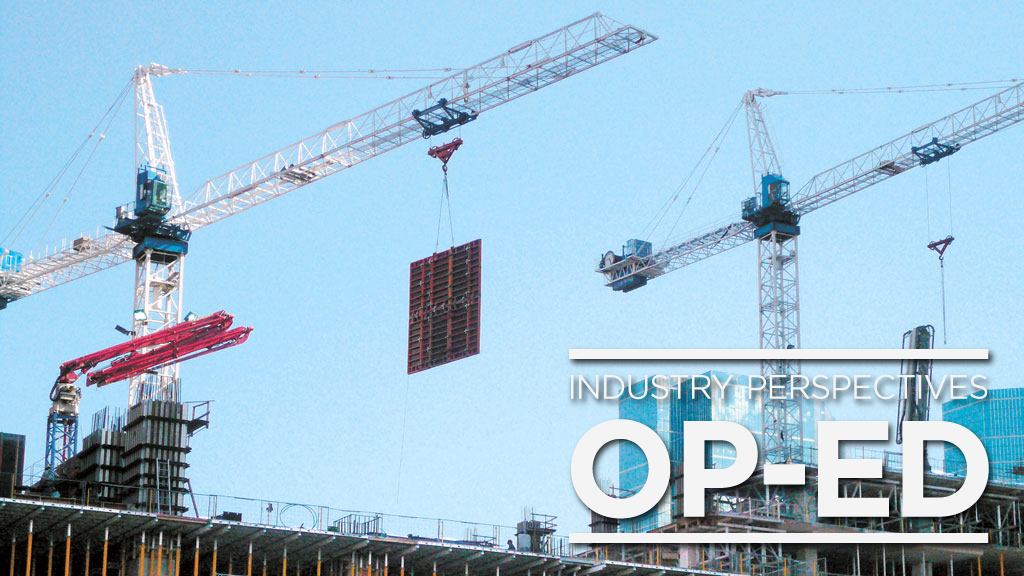This month WorkSafeBC will implement new regulations for tower cranes in B.C. that will require the use of anti-collision/zoning systems. While news of this decision is welcomed by many in the industry, the timeline for bringing the equipment into compliance remains a top concern. Part one of this story delves into why the regulations are being instituted and how the industry might be able to adapt.
News of WorkSafe BC’s decision to implement the use of anti-collision/zoning systems comes in response to newer technology that helps to ensure the safer use of tower cranes by preventing crane-to-crane collisions and crane-to-powerline collisions. The systems also provide zone control by creating safe barriers in other vulnerable settings, such as close proximity to existing buildings or to traffic.
In the specific language of WorkSafeBC’s Occupational Health and Safety Regulation (OHSR), the anti-collision/zoning systems will be mandated for tower cranes under the following two conditions: When in an overlap situation with an adjacent crane or other equipment (14.49.1); and when operating at a workplace with potential exposure to the limits of approach of electrical equipment (19.24.1).
“These systems work,” affirmed Ryan Burton, managing director of Bigfoot Crane Company, and former Board Chair of BC Crane Safety. “They make tower cranes safer.”
Burton witnessed the use of the zoning systems firsthand in the Lower Mainland when they were tested on tower cranes at the Olympic village site in Vancouver in 2010. He became convinced it was just a matter of time before the systems would become standard within the local tower crane industry, as they already were in Europe.
After Burton insisted Bigfoot start upgrading their fleet of tower cranes with the zoning systems, the company saw dramatic results.
“Although incidents were rare before, maybe one to two collisions per year with powerlines,” said Burton, “within two years of using these systems, we completely eliminated those incidents.”
According to Clinton Connell, executive director of BC Crane Safety, “The new regulations were expected, and they are certainly well intended. I haven’t heard anyone in the industry arguing against the benefits of using these systems — they are proven safety devices. However, the biggest challenge is the timeline.”
In order for the B.C. tower crane industry to comply with the new regulations, all crane owners and users that will find themselves in the two scenarios outlined in the OHSR must ensure their cranes are not only equipped with anti-collision/zoning systems by March, but that they are fully approved by a professional engineer.
“Brand new cranes are plug-and-play ready for these new systems,” said Connell. “The electrical schematics come fully compatible from the OEM. In that case, the owners just need to find a trusted vendor to install the new system and get sign-off from an engineer.”
However, the process to compliance becomes complicated when cranes are not technically ready for the newer systems.
“It completely depends on the age of their fleet,” said Connell, when considering the preparedness of crane companies in B.C. “Any tower crane built before 2006 would not be factory-ready to accommodate zoning systems, and a lot of cranes that have been in service for years may have undergone modifications that are not necessarily approved.”
“The older the crane, the more convoluted the process,” said owner of Arsenal Engineering, Ryan Stewart, who has been inspecting and certifying cranes in B.C. for 15 years. “Companies in B.C. with newer cranes will have an easier time, but my general sense is that, as an industry, we’re not prepared for these new regulations.”
“Finding a good system and installing it is not the problem,” said Burton. “The challenge is making sure that your crane’s electrical panel is not only compatible with the new systems but that any previous modifications have been approved by a professional engineer or by the OEM.”
According to Burton, the electrical panels on older cranes are the bottleneck. Before they can be fitted with an anti-collision/zoning system, they need to be brought into compliance and approved.
“That’s step one,” said Burton, “before you even start talking about adding a new zoning system.”
According to professional engineers in the crane industry, like Stewart, the problem with many of the older cranes is that they have been modified over the years, and changes may not have been approved or documented correctly.
Perhaps skilled electricians completed field fixes to keep cranes up and running, but the re-wiring did not necessarily match the schematics supplied by the OEM (a regulatory prerequisite for installing an anti-collision/zoning system). Although these older well-made cranes may be in good working order in most respects, they are not compliant with the newer systems. In some cases, the OEM no longer exists and so the road to compliance is even more difficult.
This article was written by Mark Klassen on behalf of Bigfoot Crane Company. Send Industry Perspectives Op-Ed comments and column ideas to editor@dailycommericalnews.com.
Read part two of this story next week for more on the road to compliance.











Recent Comments
comments for this post are closed